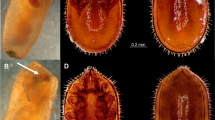Abstract
Dulosis is a type of social parasitism in which a parasitic ant has become dependent on captured workers (hosts) of a closely related species. Dulosis can be either facultative or obligate depending on the degree of dependence on host workers. As parasites become more specialized over evolutionary time, their domestic abilities degenerate until they become unable to survive without the host. However, depending on the degree of specialization, the “lost” behaviors may display some degree of recovery when host workers are unavailable to do the tasks. The 12 species of the Formica sanguinea group are all traditionally considered to be facultative parasites. However, recent studies suggest that one member of the group, F. subintegra, has characteristics that are more consistent with obligate parasitism. To explore the degree to which F. subintegra has become obligate, this study examined the degree of recovery of foraging and nest excavation behaviors of parasites when hosts are removed. When parasites were isolated from hosts, they spent more time foraging and feeding regurgitated food to nestmates (oral trophallaxis), and tended to begin feeding sooner following a period of fasting than when hosts were present. Isolated parasites were able to excavate suitable tunnels and engaged in nest building behavior significantly more often than parasites in groups with hosts. These results indicate that F. subintegra demonstrates some recovery of its foraging and nest excavation abilities, and can be considered a less specialized (more primitive) obligate parasite. Formica subintegra and its facultative relatives can be used as models for studying the progression of dulotic evolution within a closely related group of social parasites, and may shed light on which factors contribute to the transition from facultative to obligate parasitism.




Similar content being viewed by others
References
Bhatkar AP, Whitcomb WH (1970) Artificial diet for rearing various species of ants. Fla Ent 53:229–232
Bolton B (2019) AntWeb: Ants of Bolton World Catalog. Available from: https://www.antweb.org/project.do?name=worldants. Accessed 11 Feb 2019
Buschinger A (2009) Social parasitism among ants: a review (Hymenoptera:Formicidae). Myrmecol News 12:219–235
D’Ettorre P, Heinze J (2001) Sociobiology of slave-making ants. Acta Ethol 3:67–82
Holldobler B, Wilson EO (1990) The Ants. Springer Verlag, Berlin, pp 436–470, 258–259
Josens RB, Roces F (2000) Foraging in the ant Camponotus mus: nectar-intake rate and crop filling depend on colony starvation. J Insect Physiol 46:1103–1110
Kutter H (1969) Die sozialparasitischen Ameisen der Schweiz. Neujahrsbl Naturforschende Ges Zurich 171:1–62
Martin P, Bateson P (2007) Recording methods. In: Martin P, Bateson P (eds) Measuring Behavior: An Introductory Guide, 3rd edn. Cambridge University Press, New York, pp 48–61
Mori A, Le Moli F (1988) Behavioural plasticity and domestic degeneration in facultative and obligatory slave-making ant species (Hymenoptera Formicidae). Ital J Zool 22:271–285
Mori A, Grasso DA, Le Moli F (1991) Eco-ethological study on raiding behaviour of the European Amazon Ant, Polyergus rufescens Latr. (Hymenoptera: Formicidae). Ethology 88:46–62
Prather RM, Roeder KA, Sanders NJ, Kaspari M (2018) Using metabolic and thermal ecology to predict temperature dependent ecosystem activity: a test with prairie ants. Ecology 99:2113–2121
Romiguier J, Rolland J, Morandin C, Keller L (2018) Phylogenomics of palearctic Formica species suggests a single origin of temporary parasitism and gives insights to the evolutionary pathway toward slave-making behaviour. BMC Evol Biol 18:40
Sakagami SF, Hayashida K (1962) Work efficiency in heterospecific ant groups composed of hosts and their labour parasites. Anim Behav 10:96–104
Savolainen R, Deslippe RJ (1996) Facultative and obligate slavery in formicine ants: frequency of slavery, and proportion and size of slaves. Biol J Linn Soc 57:47–58
Savolainen R, Deslippe RJ (2001) Facultative and obligate slave making in Formica Ants. Naturwissenschaften 88:347–350
Stuart RJ, Alloway TM (1985) Behavioural evolution and domestic degeneration in obligatory slave-making ants (Hymenoptera: Formicidae:Leptothoracini). Anim Behav 33:1080–1088
Talbot M, Kennedy CH (1940) The slave-making ant, Formica sanguinea subintegra Emery, its raids, nuptual flights and nest structure. Ann Entomol Soc Am 33:560–577
Topoff H (1990) The evolution of slave-making behavior in the parasitic ant genus Polyergus. Ethol Ecol Evol 2:284–287
Wesson LG (1940) Observations on Leptothorax duloticus. Bull Brooklyn Entomol Soc 35:73–83
Wheeler WM (1910) Ants: their structure, development and behaviour. Columbia University Press, New York, pp 25–26, 452–487
Wilson EO, Regnier FE (1971) The evolution of the alarm-defense system in the Formicine ants. Am Nat 105(943):279–289
Wilson EO (1975) Leptothorax duloticus and the beginnings of slavery in ants. Evolution 29(1):108–119
Wobbrock JO, Findlater L, Gergle D, Higgins JJ (2011) The aligned rank transformation for nonparametric factorial analyses using only ANOVA procedures. Proc ACM Conf Hum FAc Comp Sys (CHI ‘11). AMP Press, New York. Vancouver, pp 143–146
Acknowledgements
We thank Chris Barnhart, Brian Greene, Ben Dalton, and James Trager for advice during the course of the study. We thank Steve Hunter, and Grayson, Deakin and Zeke Clover for their support. Brian Grindstaff provided technical assistance with the ant farms. Funding was provided by the Missouri State University Graduate College and Biology Department.
Author information
Authors and Affiliations
Corresponding author
Rights and permissions
About this article
Cite this article
Hunter, A.N., Mathis, A. Behavior in Transition: Recovery of Behavior by an Obligate Parasitic Ant (Formica subintegra) Following Host Removal. J Insect Behav 33, 48–58 (2020). https://doi.org/10.1007/s10905-020-09746-w
Received:
Revised:
Accepted:
Published:
Issue Date:
DOI: https://doi.org/10.1007/s10905-020-09746-w




